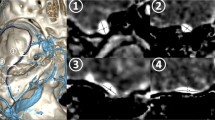Abstract
Background
The venous drainage of the temporal lobe, through bridging veins to the middle cranial fossa, is pivotal in determining the surgical corridor for skull base lesions. In dealing with select cases, where venous drainage was an obstacle in the surgical approach, we hypothesized that staged ‘intentional’ ligation of the dominant pathway of venous drainage would provide a safer and wider access to skull base tumors. We study the indications and safety of this surgical strategy in the management of skull base lesions.
Materials and methods
From 1995 to 2012, 318 patients with skull base tumors were treated at our institute by the fronto-orbito-zygomatic (FOZ) or transpetrosal approaches, eight of whom we planned for staged ‘intentional’ bridging vein ligation. Seven patients underwent planned ligation of the bridging veins from the temporal lobe to the middle cranial fossa floor in the first stage, followed by definitive surgery through the desired skull base approach, in the second stage, while in one patient the strategy was abandoned. These patients were evaluated with respect to their clinical presentation, pre- and post-operative radiology including venogram, intra-operative findings and post-operative course.
Results
Seven patients, four males and three females, with ages ranging from 16 to 63 years, underwent staged ‘intentional’ bridging vein ligation. The diagnoses were recurrent craniopharyngioma in four, and petroclival meningioma, sphenopetroclival meningioma and spheno-orbital meningioma in one each. Six of these lesions were approached from the dominant (left) side, while one lesion was on the right side. Venograms done after the first-stage procedure showed obliteration of the dominant venous drainage with opening up of anastomotic venous channels in all patients. All patients tolerated the first-stage procedure well; only one patient showed asymptomatic mild temporal lobe edema on MRI, which resolved in 3 weeks. None of the patients had venous complications after definitive surgery. One patient with recurrent chordoma, who was planned for staged ligation, did not undergo ligation as, intra-operatively, the draining channel turned out to be a cortical vein, which could be mobilized without ligation.
Conclusion
In an attempt to detether the temporal lobe, the disconnection of the bridging veins from the temporal lobe to the middle cranial fossa floor in the first stage may lead to re-direction of the venous outflow over time. This may allow skull base surgeons a better surgical corridor and ensure safety of venous structures during the definitive surgery.



Similar content being viewed by others
References
Al-Mefty O, Krisht A (1996) The dangerous veins. In: Hakuba A (ed) Surgery of the intracranial venous system. Springer Verlag, New York, pp 338–345
Gotoh M, Ohmoto T, Kuyama H (1993) Experimental study of venous circulatory disturbance by dural sinus occlusion. Acta Neurochir 124:120–126
Guppy KH, Origitano TC, Reichman OH, Segal S (1997) Venous drainage of the inferolateral temporal lobe in relationship to transtemporal/transtentorial approaches to the cranial base. Neurosurgery 41:615–620
Kageyama Y, Watanabe K, Kobayashi S, Nakamura H, Satoh A, Watanabe Y, Yamaura A (1996) Post-operative brain damage due to cerebral vein disorders resulting from the pterional approach. In: Hakuba A (ed) Surgery of the intracranial venous system. Springer Verlag, New York, pp 311–315
Nakase H, Shin Y, Nakagawa I, Kimura R, Sakaki T (2005) Clinical features of postoperative cerebral venous infarction. Acta Neurochir 147:621–626
Ohata K, Haque M, Morino M, Nagai K, Nishio A, Nishijima Y, Hakuba A (1998) Occlusion of the sigmoid sinus after surgery via the presigmoidal-transpetrosal approach. J Neurosurg 89:575–584
Sakata K, Al-Mefty O, Yamamoto I (2000) Venous consideration in petrosal approach: microsurgical anatomy of the temporal bridging vein. Neurosurgery 47:153–161
Sakata K, Yamamoto I, Sekino T (1996) Pre-operative angiographic examination of the sylvian drainage system: The rationale of intentional division of the bridging vein running off the temporal tip. In: Hakuba A (ed) Surgery of the intracranial venous system. Springer Verlag, New York, pp 163–168
Sindou M, Auque J (2009) The intracranial venous system as a neurosurgeon’s perspective. Adv Tech Stand Neurosurg 26:131–216
Conflict of interest
The authors report no conflict of interest concerning the materials or methods used in this study or the findings specified in this paper.
Author information
Authors and Affiliations
Corresponding author
Rights and permissions
About this article
Cite this article
Savardekar, A.R., Goto, T., Nagata, T. et al. Staged ‘intentional’ bridging vein ligation: a safe strategy in gaining wide access to skull base tumors. Acta Neurochir 156, 671–679 (2014). https://doi.org/10.1007/s00701-014-2028-6
Received:
Accepted:
Published:
Issue Date:
DOI: https://doi.org/10.1007/s00701-014-2028-6




